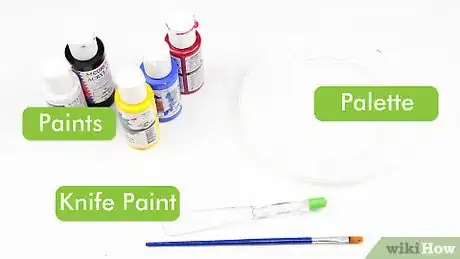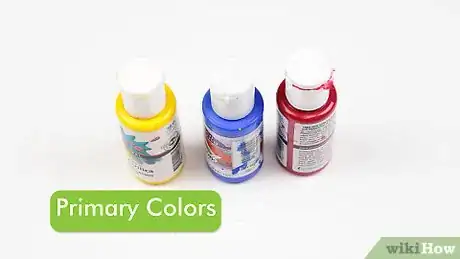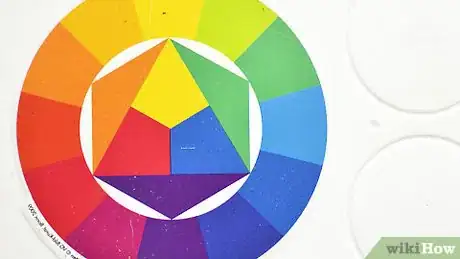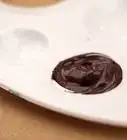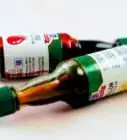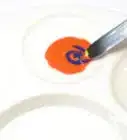This article was co-authored by Kelly Medford. Kelly Medford is an American painter based in Rome, Italy. She studied classical painting, drawing and printmaking both in the U.S. and in Italy. She works primarily en plein air on the streets of Rome, and also travels for private international collectors on commission. She founded Sketching Rome Tours in 2012 where she teaches sketchbook journaling to visitors of Rome. Kelly is a graduate of the Florence Academy of Art.
There are 12 references cited in this article, which can be found at the bottom of the page.
wikiHow marks an article as reader-approved once it receives enough positive feedback. This article has 14 testimonials from our readers, earning it our reader-approved status.
This article has been viewed 822,670 times.
Crafting that perfect shade of orange or pink can be a daunting roadblock for the beginner who doesn't know where to begin when putting their palette together. Thankfully, nearly all colors in the spectrum can be created from just a few basic colors. Learning the color wheel will give you the foundation you need to produce any hue you desire.
Steps
Mixing the Secondary Colors
-
1Gather paint-mixing supplies. You'll need a palette and a paint knife or brush in order to get started. Mixing paint with a paint knife results in a more even, uniform color compared to a brush.[1]
- If you're using brushes to mix paint, make sure to clean them in between mixing. You don’t want paint of a previous color mixing with the two you are currently mixing. Use soap and water for acrylic, or odorless mineral spirits or turpentine for oil.[2]
- You can mix your paints in a jar instead of a palette if you intend on preparing paint for later work.
- Color mixing is skill that takes hard work and experience. Practice with different amounts of paint, as well as different kinds of combinations, in order to get more acquainted with how your paints will interact.[3]
-
2Start with the three primary colors. All other colors stem from the three primary colors: red, blue, and yellow.[4] These colors cannot be made from other colors. It's useful to think of them as the base “parent” colors.
- You might consider purchasing larger quantities of the primary colors compared to other types of paint. Larger tubes of paint are often available in 200ml quantities.
- Paints come in two qualities: student grade and professional. Student grades are cheaper, but inferior than professional paints when it comes to longevity, intensity, and other factors. Student grade paints can also alter the mixing ratios required for certain colors, so be cognizant of your purchases.[5]
- Primary colors come in warm and cool tones to help you make even more colors.[6]
Advertisement -
3Mix yellow and blue to make green. Use an equal amount of yellow and blue paint. Mix them together using either a paint brush or painting knife to create green. Using an unequal amount of either paint will skew the color of the green toward whichever color was dominant – blue or yellow.
- Blue and yellow both come in warm and cool hues. A cool yellow will look greenish, while a warm yellow will look orange-ish.[7]
- To get a brighter shade of green, use a cool yellow and a cool blue, both with a greenish tint to it.
- If your green turned out murky, you might have used a warm, orangish yellow or a warm, purplish blue.
-
4Mix yellow and red to make orange. Use an equal amount of yellow and red paint. Mix them together using either a paint brush or painting knife to create orange. Using an unequal amount of either paint will skew the color of the orange toward whichever color was dominant – yellow or red.
- Like blue and yellow, red comes in both warm and cool hues. A warm red will look orangish, while a cool red will look purplish.[8]
- To get a brighter orange, use a warm, orangish yellow and a warm, orangish red.
-
5Mix blue and red to make purple. Use an equal amount of blue and red paint. Mix them together using either a paint brush or painting knife to create purple. Using an unequal amount of either paint will skew the color of the purple toward whichever color was dominant – blue or red.
- Like other shades, blue also comes in warm and cool hues. A warm blue will look more purple while a cool blue will look greenish.[9]
- To get a bright purple, mix a cool red with purple undertones, and a warm blue with purple undertones.
- If your purple came out murky, you might have used a warm, orangey red or a cool, greenish blue.
-
6Use white and black paint to alter the tinting, saturation, and shading of a color. Tint and shade refer to how light or dark a color appears. Saturation is how "intense" or grey a color appears.[10] Experiment with mixing in small amounts of white or black paint to create variations on the basic colors.[11]
- You can also lighten paint colors by adding a little bit of yellow, or darken them by adding a little bit of blue.
- Whether white and black count as primary colors is debated. For paint-making purposes, it's important to know that a variety of black shades can be created with existing paints, whereas no paints mix to create white.[12]
-
7Store all colors that you mix. Place the paint in an air tight container, such as a jar, if you are not going to immediately use the colors. You will use these colors either to paint, or to create tertiary colors. A Tupperware container is also a great option if you don’t have jars available.
- If you don’t have containers to store your paint, cover your palette with a saran wrap and store it in the fridge (or freezer for oil paints).
- You can also place a wet towel over your paints to help keep them moist until you are ready to use them.[13]
Mixing the Tertiary Colors
-
1Start with the secondary colors. These are the colors that are made from the primaries: purple, green, and orange. You may use the paints you have already mixed, or purchase tubes of the secondary colors from any art store. Make sure you have plenty of primary color paint left over as well.
- When buying the colors from a store, make sure that you buy pure "green," "purple," or "orange" shades. Don't buy a mixed shade, like red-orange or blue-green.
-
2Mix a primary and secondary color to make a tertiary. Use equal parts primary and secondary paint. Mix them together using your brush or a painting knife. Using unequal parts paint will skew the resulting color toward whichever color was dominant – the primary or secondary.
- Play around with the proportions. Use a little bit more blue than purple, and see what shade you get.
- Note that tertiary colors are always named so that their primary colors are listed first, as in "yellow-green."
-
3Create all six tertiary colors. Each tertiary color is created via the same method, an equal parts mixing of colors. Different brands of paints often have slightly different pigment mixtures, so don't worry if they color doesn't turn out exactly as you expected. There are six tertiary colors in total:
- Yellow-green.
- Blue-green.
- Blue-violet.
- Red-violet.
- Red-orange.
- Yellow-orange.
Mixing Browns, Blacks, Neutrals, and More
-
1Mix a tertiary color with a primary color to create brown. Specifically, mix the tertiary color with the primary color that is not already a part of the tertiary color’s mix. In the case of browns, the ratio of each paint will affect the type of resulting brown.
- Adding a greater portion of warmer color, such as red, will result in a warmer brown.
- Using greater quantities of colder colors, such as blue and green, will result in a brown that is very dark, nearing black in color.
-
2Mix complementary colors to achieve black. Complementary colors are those that are considered opposite one another on the color wheel. Examples include red and green, or blue and orange. Mixing these colors together will create a black mixture that leans toward one of the colors used in the mix. This is referred to as chromatic black.
- A dark blue and brown can also provide a deep black that may be keyed cooler or warmer depending on the ratio of paints.
- Note that purchasing a pure black paint from the tube will limit your mixing opportunities with that particular black.[14]
-
3Mix a primary, analogous, and complement for gray. An analogous color is one located next to a particular color on the color wheel. For example, analogous colors of green are yellow and blue. Adding an analogous color to a color plus compliment mixture will neutralize the intensity of the color, creating a more grey color. Add white to lighten the value of this mixture until you are satisfied with the grey.
- Dark colors mix more easily into light than vice versa. Mix a small amount of the grey mixture into white to start, and add more as necessary.
-
4Use the color wheel. With the three main color groups at your disposal, you have every color you need to create any color you can think of. When in doubt about what is needed to create a particular color, look at the color wheel. Look at where the color falls on the wheel, and mix the two parent colors that the color falls between.[15]
- Use white (or yellow) to lighten a color.
- Use a complement of a particular color to key the color toward grey.
- Darkening a color requires an addition of one of its parent colors, depending on which color you wish to lean toward.[16]
Expert Q&A
Did you know you can get premium answers for this article?
Unlock premium answers by supporting wikiHow
-
QuestionWhat colors do I mix to make different colors?
 Kelly MedfordKelly Medford is an American painter based in Rome, Italy. She studied classical painting, drawing and printmaking both in the U.S. and in Italy. She works primarily en plein air on the streets of Rome, and also travels for private international collectors on commission. She founded Sketching Rome Tours in 2012 where she teaches sketchbook journaling to visitors of Rome. Kelly is a graduate of the Florence Academy of Art.
Kelly MedfordKelly Medford is an American painter based in Rome, Italy. She studied classical painting, drawing and printmaking both in the U.S. and in Italy. She works primarily en plein air on the streets of Rome, and also travels for private international collectors on commission. She founded Sketching Rome Tours in 2012 where she teaches sketchbook journaling to visitors of Rome. Kelly is a graduate of the Florence Academy of Art.
Professional Painter
-
QuestionCan I make white paint at home?
 wikiHow Staff EditorThis answer was written by one of our trained team of researchers who validated it for accuracy and comprehensiveness.
wikiHow Staff EditorThis answer was written by one of our trained team of researchers who validated it for accuracy and comprehensiveness.
Staff Answer wikiHow Staff EditorStaff Answer
wikiHow Staff EditorStaff Answer -
QuestionHow do you lighten a paint color?
 wikiHow Staff EditorThis answer was written by one of our trained team of researchers who validated it for accuracy and comprehensiveness.
wikiHow Staff EditorThis answer was written by one of our trained team of researchers who validated it for accuracy and comprehensiveness.
Staff Answer wikiHow Staff EditorStaff Answer
wikiHow Staff EditorStaff Answer
Warnings
- Many paints contain dangerous metals, such as lead and cadmium, so avoid ingesting the paint, or prolonged skin contact.⧼thumbs_response⧽
Things You'll Need
- Tubes of primary colors; red, yellow, and blue.
- Tubes of white and black.
- Clothing that can get dirty.
- A palette.
- Paint brushes.
- A painting knife.
- Jars or other air tight containers.
References
- ↑ http://www.finearttips.com/2014/05/palette-knife-painting-tips/
- ↑ http://emptyeasel.com/2008/12/29/13-tips-for-working-with-acrylic-paints/
- ↑ http://kevinmccainstudios.com/color-mixing-mixing-beautiful-grays/
- ↑ Kelly Medford. Professional Artist. Expert Interview. 10 March 2021
- ↑ http://www.finkeldeistudio.com/how-to-articles/oil-acrylic-painting/34-what-you-should-know-about-oil-paints
- ↑ Kelly Medford. Professional Artist. Expert Interview. 10 March 2021
- ↑ http://www.justpaint.org/color-mixing-you-cant-get-it-unless-you-do-it/
- ↑ http://www.justpaint.org/color-mixing-you-cant-get-it-unless-you-do-it/
- ↑ http://www.justpaint.org/color-mixing-you-cant-get-it-unless-you-do-it/
- ↑ http://www.colorsontheweb.com/colorterms.asp
- ↑ Kelly Medford. Professional Artist. Expert Interview. 10 March 2021
- ↑ http://www.colormatters.com/color-and-design/are-black-and-white-colors
- ↑ http://www.explore-acrylic-painting.com/acrylic-painting-tips.html
- ↑ http://willkempartschool.com/the-3-myths-of-black-in-mixing-paint-colours/
- ↑ http://www.colormatters.com/color-and-design/basic-color-theory
- ↑ http://www.easy-oil-painting-techniques.org/color-mixing.html
About This Article
One easy way to make paint colors is to mix paints you already have. Start with the 3 primary colors—red, yellow, and blue. Combine the colors on a plate or palette with a brush or a paint knife. Experiment with mixing different combinations, such as blue and yellow to make green or red and yellow to make orange. You can always adjust how much of each color you add to change the hue. For example, to make bluish-purple, mix red and blue, but use more blue. To make a color lighter or darker, add a bit of white or black paint. You can also mix in gray if you want a less intense tone. Once you’ve mixed your colors, store them in airtight containers so they don’t dry out. If you want to learn how to combine colors to get brown or grey, keep reading the article!
